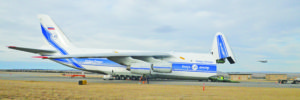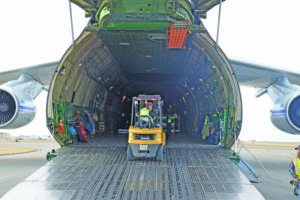
One of the world’s largest cargo planes, an Antonov An-124 Russian plane, rest at Billings Logan International Airport while crews pivot the nose upward in preparation to load humanitarian supplies headed for an Asian island destroyed by a typhoon. Crews are securing the inside of the cargo plane while an F-18 Super Hornet fighter jet departs in the background after refueling on Monday December 17, 2018. (Jonathan McNiven Photo)
Billings – Five Russian flights are halfway through their scheduled plans to help transport humanitarian materials and supplies from Billings Logan International Airport to the Pacific Island of Saipan to rebuild a community that was devastated by a natural disaster. Using one of the largest aircraft in the World (Antonov 124), Shane Ketterling, Assistant Director of Aviation & Transit at Billings Logan International Airport, told the Yellowstone County News that “We were the last to know about this and have been scrambling to coordinate all of the logistics over the past 48 hours.”
Monday’s landing of the huge Russian cargo plane marked the third of the five scheduled flights to Billings while logistics and coordination between flight crews’ sleeping schedule and loading had to be adjusted.
“The aircraft will be parked in the middle of the airfield for approximately 14 – 16 hours during each stop here to load supplies and for crew rest.”

A forklift operator loads steel onto one of the world’s largest cargo planes Monday afternoon at Billings Logan International Airport. Here, the forklift looks small in comparison to the massive space available inside to store and transport material to the devestated area. (Jonathan McNiven Photo)
While part of the west side of the airfield was closed to plane traffic, truckloads of supplies from Bridger Steel were being loaded carefully into the cargo plane by a forklift in preparation to transport. Elias Hernandez, Project Logistics Executive for Volga Dnepr, told the Yellowstone County News that Monday’s flight can only hold so much weight as this flight is being provided by a local company Bridger Steel with steel. Based out of Woodland, Texas, Elias and his forklift operator, catches a flight to Billings in preparation to assure the cargo is loaded and secured correctly on the plane. As this is one of the world’s largest cargo planes, Elias’s job entails inspecting each load and ensuring its ready to transport once the flight crew is rested. Elias stated that this cargo plane can transport about 120 metric tons, which is about 265,000 lbs. “That’s a heavy load” he stated, as it takes 20 special wheels on the back side of the plane to support the cargo.
According to online sources, the Antonov An-124 Ruslan plane is a strategic airlift jet aircraft. It was designed in the 1980s by the Antonov design bureau in the Ukrainian SSR, then part of the Soviet Union. Until the Boeing 747-8F, the An-124 was, for thirty years, the world’s heaviest gross weight production cargo airplane and second heaviest operating cargo aircraft, behind the one-off Antonov An-225. The An-124 remains the largest military transport aircraft in the world. The lead designer of the An-124 was Viktor Tolmachev.
Not only is this plane unique in transport, the way cargo is loaded is also unique. Once the plane is stopped and secured, the front nose of the plane is completely hinged and pivoted upwards so that cargo is loaded from the frontend of the plane, not the back. The nose of the plane and all electronics are pivoted upwards to allow the forklift and all supplies to be loaded. Once the cargo plane is loaded, the nose of the plane is readjusted so the pilots and flight crew can crawl back into the cockpit for departure.
Shane Ketterling, Airport Assistant Director, communicated by email about the reasons for the flight. “These flights are in response to Typhoon YuTu that occurred a couple weeks back. The building material is being supplied by Bridger Steel and is critical as most of the structures where demolished by the Cat 5 typhoon (the eye wall passed right over the southern side of the island.) Most of the initial flights were for food, water, hygiene kits, and temporary shelters – tents. The materials originating from our area is to help the island rebuild from the foundation up. These operations are being funded by FEMA, contracted out to Radiant, who are utilizing Volga-Dnepr Aircraft to move the materials.”
Edwards Jet Center is also heavily involved in the safe operation of this endeavor since they are fueling and ground handling the aircraft during the scheduled flights.
If everything goes as scheduled, which has not been the plan so far, the last of the 5 flights is scheduled for departure on Sunday December 22.
Editors Note: If you call this Russian collusion, I like it!
JDM

